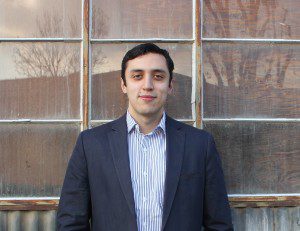Today I have the great privilege of speaking with Dr. Lloyd Barba, Assistant Professor of Religion at Amherst College about his wonderful new book and his insightful, compassionate research.
Lloyd! You know you’re one of my favorite people. But you are also a completely brilliant scholar–thank you for talking with me today.
Ansley, your warmth and demeanor did not really allow me to sit on the anxious bench of friendship for very long. We became friends within minutes! The feeling is totally mutual.
Your new book Sowing the Sacred: Mexican Pentecostal Farmworkers in California came out with Oxford University Press last August. I know the subject is personal for you in many ways. Why did you decide to write this book?
Goodness, there were many reasons indeed to write this book, but I’ll keep it short here.
Over the years, I had become familiar with the government photographs that captured Mexican farmworkers out in the dizzying rows of crops. The typical portrayal is that of so-called “stoop laborers,” silhouettes with little to no detail such as names, place of origin. I wondered: what story can be told if we look at the photographs that farmworkers took of themselves in moments, yes, of work, but also in moments of worship?
Back in 2013 I helped with processing and organizing or two massive archival collections at Fuller Theological Seminary. I was not employed by Fuller but spent countless hours deep down in the basement trying to make sense of these collections. The first, Manuel J. Gaxiola Collection, came from Mexico City and the second, The Papers of Manuel Vizcarra, arrived from down the Inland Empire down the freeway. Fuller was chosen because of its location in Southern California, state-of-the art facilities, and their dedication to building up archives on Pentecostal-Charismatic studies. After working with these collections and getting to know Milca Montañez-Vizcarra, the donor of the Vizcarra Papers, it became very apparent that there was a whole story to be told about Mexican Pentecostal farmworkers just in California alone. The more oral histories I conducted, the more I realized how widespread these shared experiences were.
I also wrote this book to put multiple fields of scholarship in conversation: history (U.S. West, borderlands, immigration) religion (U.S. Pentecostalism & material culture), and ethnic studies (especially Latinx studies). These are my three fields of formal training and felt like something was deeply missing by not interpreting the material of one in light of the other. I’d like to think that the payout and lots of extra work was plentiful.
Oh definitely! Can you sum up the main argument you found, drawing on all of these fields?
So, here it is in a nutshell: any historian of the U.S. West will tell you about the widespread exploitation and racialization of Mexican farmworkers West and religious historians will know a bit about the marginalization of Pentecostals in the movement’s early years. Speaking in tongues, divine healing, the charismata anywhere and everywhere rendered Pentecostals as religious outsiders (to borrow R. Laurence Moore’s term). I contend in the book that the simultaneous racialization and religious marginalization operated as oppositional forces that ultimately strengthened Mexican Pentecostals’ resolve to assert their agency in ways that we might not expect to find. (Our guild’s ideological parameters often occlude such readings.) I also take seriously the fact that the movement I studied, Mexican Oneness Pentecostalism (they called themselves Apostólicos), was one of linguistic outsiders since they were Spanish speakers in the U.S. They were also theological pariahs in their rejection of the doctrine of the Trinity. The politics of their outsider status sets them so far out of the social and religious mainstream that they ultimately bound together as a heterodox group and relied on unorthodox modes or resistance.
One of the strengths of the book is your great care in telling the stories of farmworkers in the early 20th century. You take their beliefs, art, material culture, narratives seriously. Can you talk about that process of researching with deep care?
Listening was key, and asking lots of questions when I did not understand something was all important. I incorporated over two dozen interviews/oral histories in the book (23 of which I conducted myself). I’m not embarrassed to admit when I don’t know something and I think that helped me get the stories right and with details intact. Plus, I had many questions to ask given that I researched the period from the late 1910 to the mid 1960, decades before I was born. So even though I’m well informed on matter of California history, Mexican labor, Pentecostalism, I did not want to treat Mexican Pentecostals as a homogenous group. Even though many of the interviewees testified to similar themes, they all told unique stories. Doctrinal nuances, for example, mattered a great deal to them, so I made them matter in the book.
The material and visual culture dimensions came a bit later into the research. Initially, I thought I would simply conduct archival research, but the archives (aside from the one I helped build up) yielded very little outside of what I drew up from the collections at Fuller. I knew there would be elements of oral history, but those quickly snow-balled. I found it important to get perspectives from different family members who were in different parts of the state around the same decades. As I conducted these oral histories, it seemed that everyone had photographs that they were eager to share with me. The way that these photographs were stored, how they evoked stories (even nostalgia), and the content of the photographs made clear to me that I would need a different set of tools to best tell those parts of their stories…so, to material culture I turned. Absent that keen interest in material culture, the book would have largely missed the relationship between the very physical work farmworkers performed and their spiritual strivings.
Yes, so important to take people’s experiences and beliefs seriously, and also to consider the relationship between ideas and materiality. It seems you had to essentially create a usable archive. I’d imagine this is because these people’s experiences are often erased. How did Mexican farmworkers face both racial and religious discrimination? What did that reveal to you about inclusion in America and in American religion? How did farmworkers in turn remake California?
I make the case throughout that we’re talking about a group that recognized its outsider status (on many levels!) and thus dug their heels in even deeper into the soil of heterodoxy.
The racial discrimination was quite awful and widespread. To describe the harsh context that Mexican farmworkers entered, I use the term “profane” but not in the classical sense of profane meaning that which is outside or beyond the sacred temple. Rather, throughout the book the term “profane” is meant to capture the abundantly documented and notorious conditions that Mexicans faced in industrial agriculture in California during this period: dehumanization, biological reductionism, delousing, DDT fumigation, pesticide exposure while out at work, wage exploitation, relegation to the status of replaceable laborers, squalid housing, polluted water, denial of cultural and legal citizenship, and deportation along with its constant threats. A combination of these experiences proved to be the norm during this time period. As I briefly mentioned above in response to your question about the book’s argument, here we’re talking about Pentecostals…and Oneness Pentecostals at that. Their theological heterodoxy (at least for the period I study) placed them far beyond the pale of doctrinal amenability with the broader world of Pentecostalism or Christianity for that matter.
This is a story of American religion, full stop. The peculiar circumstances of work and worship offer us a new way of telling American religious history. Many have far too often conflated “Mexican” with “worker” and for many good statistical reasons so much of Mexican history has focused on labor history. The people who fed America lived lives beyond work and Sowing the Sacred documents one way in which that happened.
Yes, so good. What surprised you most in researching and writing this book? Or a favorite archival find/story?
I would ask the former farmworkers something to the effect of: “if the congregations were comprised of impoverished farmworkers, how did they manage to build churches and fund projects?” The one-word answer was: tamales.
Tamales!?
Yes, by making and selling tamales women were the financiers of the movement. Chapter 4 documents this closely. But there’s more to this story than just finances. In true Pentecostal fashion, these spaces of continued labor also became sites of deep spiritual development as the women worked with each other for hours upon hours. The private space afforded to them during these long hours built strong bonds between each other. The irony in this story is that the denomination (even to this day) denies women ordination yet without the labor of women the movement you really don’t have the numerically successful movement.
Gosh, I love that story. Yet another way that the real work gets overlooked when discrimination—be it gendered or racial—warps our perceptions. Speaking of, we are still in a moment where migrants and workers are regularly dehumanized. How do you hope your work counters that? What would you encourage people of faith to remember in this moment?
At its core, Sowing the Sacred seeks to put names and faces to anonymous so-called “stoop laborers,” to understand their theological desires, artistic creativity, and sure place in American history. In the book I share recollections of individuals to move away from the one-dimensional view of a people long seen as just a laboring force.
To people of faith, I’d urge: remember the humanity of each person. Those tempted by this language of the threatening collective/horde/invasion might wish to consider the image of God in each person rather than the projection of a political grievance. All that sort of language strips individuals of value and dignity. Learn to discern and interpret any dehumanizing language or metaphors that reduce people to hordes, masses, etc. Anthropologist Leo Chavez’s book Covering Immigration has tremendously shaped my thinking on analyzing images and rhetoric associated with immigration.
The historian in me would further remind folks that the notion of the “Mexican problem” is one of the oldest rhetorical tricks in a xenophobic playbook that’s over a century old. Today, it’s simply projected more broadly onto Latin American migrants. It’s effective because it offers a false sense of explanatory power to terribly complex issues. Such language of “problem” and “invasion” opens the door wide open to abuse, exploitation, and violence…even from the most well-meaning people.
A powerful reminder, thank you. OK, for the many people who now want to keep up with you, where can we find you?
I’m on Twitter @ElProfeBarba or you can find me at Amherst’s many coffee shops working on the next projects!
Well, we are eagerly awaiting them! Thanks for doing this, friend.
Lloyd’s wonderful book is available in paperback here. And because he’s the best, he’s also provided a 30% discount promo code: AAFLYG6. Y’all go get it!















